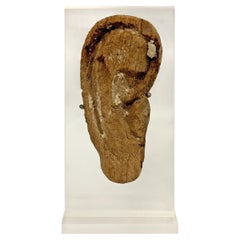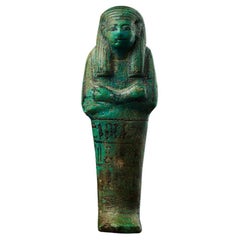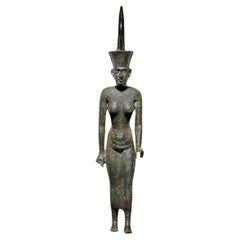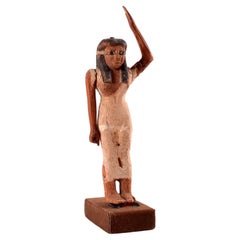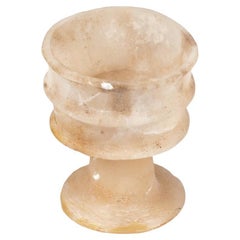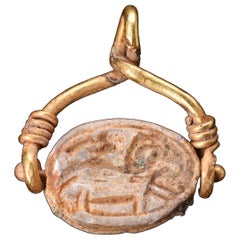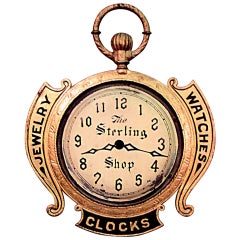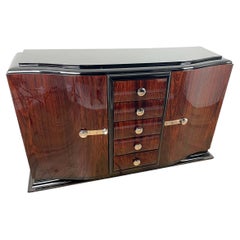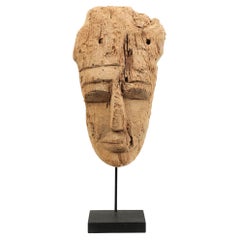Egyptian Antiquities
13
to
1
8
5
13
13
13
12
1
4
3
3
3
2
703
490
183
154
150
Place of Origin: Egyptian
Late-Period to Ptolemaic Period Egyptian Wooden Mummy Mask Ear on Custom Mount
Located in Chicago, IL
This Late Period to Ptolemaic Period Egyptian carved wood ear, once part of a mummy mask, stands as a poignant testament to ancient Egyptian customs and beliefs. Dating back over 250...
Category
15th Century and Earlier Egyptian Antique Egyptian Antiquities
Materials
Wood
Ushabti for Imenmes
Located in London, GB
A mummiform ushabti in blue faience. Four registers of hieroglyphic characters are painted around the lower half of the ushabti, with a vertical column of hieroglyphs in the centre o...
Category
15th Century and Earlier Egyptian Antique Egyptian Antiquities
Materials
Faience
Statuette of the Goddess Neith
Located in London, GB
Bronze statue of the goddess Neith, striding, her left foot extended forward. Her left hand is extended forward and formally held a papyrus sceptre, a fragmentary ankh is visible in her right hand. She wears a close-fitting sheath dress, incised with a broad usekh collar, and carefully engraved bracelets and armlets. On her head is the Red Crown of Lower Egypt, decorated with vertical striations and restored spiral and spire. Her face is finely molded, with a broad upturned nose and electrum-overlaid eyes and eyebrows.
Neith was one of the earliest recorded gods in the Egyptian pantheon, worshipped from early in the Predynastic era through to the arrival of Roman rule. A war goddess and goddess of weaving, she was the patron goddess of the Red Crown of Lower Egypt and the city of Zau (Sais, in the 5th Nome of Lower Egypt) in the Delta. A powerful and popular goddess, she was, according to the Iunyt (Esna) cosmology, the creator of the world and the mother of the sun, Ra. This made her the mother of all of the gods, who often came to her to settle their disputes.
Her symbols are the bow and arrows and a sword and shield as a war goddess, a weaving shuttle as a funerary goddess, and the Red Crown of Lower Egypt as the goddess of creation and mother goddess. She is usually depicted as a woman wearing the Red Crown of Lower Egypt, however, she is occasionally depicted as a cow in connection with her role as the mother of Ra.
The use of electrum, a naturally occurring alloy of gold and silver sometimes called ‘green-gold’, for the eyes speaks to the high status of the object. Electrum had been used by the Egyptians since at least the 3rd millennium B.C., but, give its rarity, was reserved for the most expensive and important objects. Most electrum used in Egypt was imported from Nubia, though some was found there.
Published:
Parke-Bernet Galleries, New York, February 25th, 1971, no. 70, illus.
Sotheby’s, New York, June 5th, 1999, no. 31, illus.
David Aaron Ltd...
Category
15th Century and Earlier Egyptian Antique Egyptian Antiquities
Materials
Bronze
An Egyptian wooden female offering bearer figure, Middle Kingdom
Located in UTRECHT, UT
Standing female wearing a tight fitting white dress and black tripartite wig, serene facial features with large painted eyes. Separately made arms attached with dowel to the shoulder...
Category
15th Century and Earlier Egyptian Antique Egyptian Antiquities
Materials
Wood
An Egyptian alabaster ribbed cup, New Kingdom, 18th dynasty
Located in UTRECHT, UT
The cup hand-carved from white alabaster with caramel and white veining throughout the composition. The cup stands upon a tapering base, and widens to form the ribbed, cylindrical cup.
Alabaster was a material prized by ancient sculptors...
Category
15th Century and Earlier Egyptian Antique Egyptian Antiquities
Materials
Alabaster
Egyptian Steatite Scarab in Gold Pendant
Located in London, GB
An Egyptian steatite scarab with incised features and hieroglyphs to the reverse. The front anatomy features a detailed head and clypeus with incised linear decoration to mark the prothorax and elytra. The reverse side is hard to distinguish. Mounted in a high karat later gold swivel pendant...
Category
15th Century and Earlier Egyptian Antique Egyptian Antiquities
Materials
Gold
Swivel Gold Ring with Egyptian Scarab
Located in London, GB
An Egyptian steatite scarab encased in a possibly later, high-karat gold swivel ring. The scarab is a symbol of rebirth and protection and is decorated with six sacred serpents, repr...
Category
15th Century and Earlier Egyptian Antique Egyptian Antiquities
Materials
Gold
Old Cedar Wood Sweet Refined Egyptian Mummy Mask
Located in Point Richmond, CA
Elegant old cedar wood sweet Egyptian mummy mask, 8 3/4 Inches high. Soft weathered surface and great expression. Areas of chips erosion and little bits mis...
Category
15th Century and Earlier Tribal Antique Egyptian Antiquities
Materials
Organic Material, Wood
Two Glass Inlay Pairs
Located in London, GB
Two pairs of two halves from the same bar, finely detailed, with pointed ears and eyebrows, opaque yellow face, opaque red on the mouth, nose, eyes and ears, translucent cobalt blue edges to the mouth, nose and ears, with translucent emerald green leaves above and between the translucent cobalt blue brows and eye line, translucent pink pupils, with translucent cobalt blie and opaque white snake scales below the face, in translucent cobalt blue matrix, cut in the lower part of a cartouche design.
These rare heads might represent the Agathos Daimon, the tutelary deity of Alexandria, who was also identified with Serapis, the male counterpart of Isis-Thermouthis (who in turn was a graecisized form of the early snake harvest goddess Renenutet). In a statue of Isis-Thermouthis in Alexandria museum (no. 25773, ex-collection King Farouk I), reproduced in Gotten, Pharaonen, no. 151, the snake goddess...
Category
15th Century and Earlier Antique Egyptian Antiquities
Materials
Glass
1890's Antique Egyptian Cotton Applique Tapestry
Located in Plainview, NY
A late 19th century Circa 1890's antique Egyptian cotton applique tapestry featuring intricate designs and in a brown and beige tone color. The tapes...
Category
19th Century Egyptian Revival Antique Egyptian Antiquities
Materials
Cotton
Ancient Coptic Textile with Classical Figures
Located in Philadelphia, PA
Finely woven of wool and linen, this large, ancient, museum level Coptic textile depicts figures derived from classical antiquity, some playing musical ...
Category
15th Century and Earlier Classical Roman Antique Egyptian Antiquities
Materials
Wool, Linen
Roman Egyptian 100 AD Lavender Colored Scarab and 21-Karat Gold Pendant
Located in Atlanta, GA
Roman Egypt lavender colored scarab (circa 100 BC-100 AD) set into a custom 21-karat gold decorative u-drop pendant and bail. This gorgeous purple amethyst scarab...
Category
15th Century and Earlier Antique Egyptian Antiquities
Materials
Amethyst, Gold
Egyptian Ptolemaic Period Mummified Stoneware Shabti Figure
Located in Bishop's Stortford, Hertfordshire
A rare and unusual large sized Egyptian mummified Shabti figure dating from the Ptolemaic Dynasty 305-30BC or possibly earlier. The stone figure is carved in a lying position with wo...
Category
15th Century and Earlier Egyptian Antique Egyptian Antiquities
Materials
Stone
Related Items
American Country Tole Gold Clock Sign
Located in New York, NY
American Country (19th Century) painted tole gold trimmed double sided clock sign in the form of a pocket watch.
Category
19th Century Folk Art Antique Egyptian Antiquities
Materials
Tôle
Art Deco Sideboard in Rosewood from Paris Around 1925
Located in Greven, DE
We were able to acquire this wonderful piece of furniture directly from Paris. The sideboard has a wonderful rosewood veneer which, with the reddish tones, creates a nice contrast to...
Category
1920s Art Deco Vintage Egyptian Antiquities
Materials
Marble, Chrome
Pair of 18th Century Italian Rococo Gold Leaf Tassel Ornaments
By Interi
Located in Dublin, Dalkey
Pair of 18th century Italian hand-carved gold leaf tassel ornaments.
They are two of the same shape of tassel but in two different sizes ...
Category
18th Century Rococo Antique Egyptian Antiquities
Materials
Gold Leaf, Metal
1970s Piaget Lady Watch in Gold and Jade
Located in Milan, IT
1970s Piaget lady gold watch, with the face watch in Jade, with original watch strap in alligator signed by Piaget.
In excellent condition, it works p...
Category
1970s Modern Vintage Egyptian Antiquities
Materials
Jade, Gold
1899 Silver & Enamelled Scent Bottles in a Silver Box
By WILLIAM HORNBY, LONDON (1898-1913)
Located in Hong Kong, HK
1899 Silver & Enamelled Scent Bottles, Hallmarked: William Hornby, London, 1899
Silver Box in the shape of a Horseshoe opening and revealing thr...
Category
1890s Antique Egyptian Antiquities
Materials
Silver, Enamel
Moche Copper Bronze Mask
Located in San Pedro Garza Garcia, Nuevo Leon
A large coper mask of a dignitary with almond shaped, inset shell eyes with pupils and a wide brim type crown. Attached at the brow line, a row of danglers is suspended, aligning the...
Category
15th Century and Earlier Pre-Columbian Antique Egyptian Antiquities
Materials
Copper
Vintage Black and Chrome Schwinn Phantom Replica
Located in Brooklyn, NY
Built between 1949 and 1959, Schwinn Phantoms were the most bodacious, luxurious, and feature-filled bicycles on the road. There was the deluxe patented spring fork, built-in horn, s...
Category
20th Century Mid-Century Modern Egyptian Antiquities
Materials
Metal
18th Century Italian Speckled Gold and Silver Leaf Tassel Ornaments 'Set of 5'
By Interi
Located in Dublin, Dalkey
18th Century Italian hand-carved speckled gold and silver leaf tassel ornaments.
The tassels originally came from an Italian church in Tuscany and were used during feast days. These tassels were commonly used to adorn 18th and 19th century French and Italian chandeliers...
Category
18th Century Rococo Antique Egyptian Antiquities
Materials
Gold Leaf, Metal
Large Antique Lighter, Iron, France, Early 20th Century
Located in Greven, DE
Exceptional lighter from heavy iron, France, early 20th century.
Not functional.
Category
Early 20th Century Art Deco Egyptian Antiquities
Materials
Iron
Pre Columbian Rare Lambayeque Wood Figure
Located in London, GB
Pre columbian Lamabayeque wood figure Peru Circa 750 to 1375 AD
A rare standing figure of a deity with triangular tear drop shaped eyes holding a child,
Carved in very dense heavy hard wood
Measures: Height 14 inches, 36 cm weight, 1.5 kg approx
Ex collection of a Oxford Academic, reputed to have came from Pit rivers...
Category
15th Century and Earlier Antique Egyptian Antiquities
Materials
Wood
Ancient Greek Terracotta Antefix in Form of the Head of Artemis Bendis, Taranto
Located in Antwerp, BE
Ancient Greek mould-made terracotta antefix decorated with the female head of the Goddess Artemis Bendis.
Western Greek, Italy, Taranto, early 4th century BC.
Two small feathered win...
Category
15th Century and Earlier Classical Greek Antique Egyptian Antiquities
Materials
Ceramic
Fine and Rare Early 19th Century Carved Bootjack in the Form of a Pistol
Located in Oxfordshire, United Kingdom
A fine and rare !9th Century hand carved antique treen bootjack, to remove riding boots, in the unusual form of a pistol.
This is a rare find and unfolds to form a bootjack with be...
Category
19th Century Antique Egyptian Antiquities
Materials
Beech
H 2.13 in W 10.63 in D 1.82 in
Previously Available Items
Ancient Egyptian Cedar Wood Sarcophagus Mummy Mask on Stand
Located in Point Richmond, CA
Ancient Egyptian cedar wood sarcophagus mummy mask.
Carved solid cedar wood Egyptian sarcophagus mask, weathered and eroded surface from age, pins on rea...
Category
15th Century and Earlier Egyptian Antique Egyptian Antiquities
Materials
Wood
Ancient Egyptian Purple Amethystine Quartz Ointment Vase
Located in London, GB
From the Old Kingdom onwards, many descriptive wall reliefs and paintings can be found depicting the production of various stone vessels . We can infer from these portrayals that the...
Category
15th Century and Earlier Antique Egyptian Antiquities
Materials
Stone
Bronze Osiris
Located in London, GB
This statuette is in keeping with the canonical iconography of Osiris: in his hands, he holds the flagellum, the nekhekh and hekat scepters, and on his head he wears his usual atef c...
Category
15th Century and Earlier Antique Egyptian Antiquities
Materials
Bronze
Figure of Onuris
Located in London, GB
This arresting Egyptian bronze depicts Onuris, the god of war and patron of the army. He stands with his leg foot stepping forwards, his muscular arms set in a powerful pose. His rig...
Category
15th Century and Earlier Antique Egyptian Antiquities
Materials
Bronze
Head of Anubis
Located in London, GB
Anubis the God of Death is among the most iconic gods in ancient Egypt and people during this time knew him as Anpu or Inpu. Anubis is among the oldest deities whose mentioning can b...
Category
15th Century and Earlier Antique Egyptian Antiquities
Materials
Wood
Large Faience Ram
Located in London, GB
Strikingly similar to the Romano-Egyptian Ram currently in the Met this piece depicts a ram, with a highly textured and naturalistically modelled coat, curled horns and a static forw...
Category
15th Century and Earlier Antique Egyptian Antiquities
Materials
Ceramic
The 'Gillot' Taweret
Located in London, GB
This statuette represents the goddess Taweret, an apotropaic goddess, whose domain was the protection of pregnant women and their babies, especially during childbirth. Her threatenin...
Category
15th Century and Earlier Antique Egyptian Antiquities
Materials
Limestone
Ushabti of 'Paser'
Located in London, GB
An Ushabti is a funerary figurine used throughout ancient Egypt, placed in a tomb to aid as a servant to the deceased, conducting manual labour for them...
Category
15th Century and Earlier Antique Egyptian Antiquities
Materials
Limestone
Ushabti of 'Kenj'
Located in London, GB
The XIX Dynasty of Ancient Egypt was part of the Egyptian New Kingdom and was founded by Vizier Ramasses I, whom Pharaoh Horemheb chose as his successor to the throne. The XIX Dynasty is best remembered for its military conquests in the lands of Canaan. The relative peace of the XVIII Dynasty gave way to a century of wars, which produced art that attempted to maintain ancestral traditions in order to claim its dynastic lineage and succession to the throne.This large serpentine statue tells of the prominence of administrative art during this period. The figure is an ushabti, a funerary statue that would have been placed in a tomb among the grave goods of the inhabitant, intended to act as a servant for the deceased in the afterlife. The ushabtis would be called upon to perform their menial tasks, each figure's purpose is often attested to by objects in their hands, such as bread-baker holding grain or farmer holding a scythe, and they would be donated by the workers of the deceased to fulfill their roles for them in death. Hieroglyphics could often also be found running the length of their legs giving further clues to their roles and stating whom they intended to work for. These inscriptions were called answers and asserted the figures readiness to be summoned to the gods work The practice of placing ushabtis inside tombs originated in the Old Kingdom, with the earliest evidence from the middle of the third millennium B.C. when they buried next to mummies[2]. They are normally miniature in size, of hard stones such as limestone, granite or serpentine (and occasionally of faience or bronze), and produced in multiples to provide the important deceased with an army of workers. Sometimes so many were produced that they world cover the entire surface floor of a tomb. Due to this commonness, many extant examples survive, in varying qualities, and as a collection of artifacts they provide a unique insight in to the fascinating death customs of the Ancient Egyptians, highlighting their very real belief in an eternal afterlife.This beautifully carved statue holds hoes and a seed sack, indicating they were destined for manual toil in the eternal afterlife amongst the fields growing grain to produce food for the interred. Another agricultural implement with crisscrossing ropes is tucked in to the back of the figure's kilt, making sure he is ready for any farming situation necessary. He wears a long-sleeved shirt with a long pleated kilt, which has a large over-fold and broad beaded collar. He also wears a double wig composed of zig-zags and echeloned curls, and his face has a slightly aquiline nose, with almond-shaped eyes a fixed, determined gaze.A column running the length of his over-fold contains five lines of hieroglyphic inscription that name the owner of the worker (Kenj), and recite chapter VI from the Ancient Egyptian Book of...
Category
15th Century and Earlier Antique Egyptian Antiquities
Materials
Granite
Cosmetic Duck Vessel
Located in London, GB
This vessel, carved in the form of a wild duck, would have served the purpose of a cosmetic vessel or 'toilet spoon'. Comprised of three individual sections, the head is attached to ...
Category
15th Century and Earlier Antique Egyptian Antiquities
Materials
Wood
Egyptian Ptolemaic Period Green Faience Shabti Figure
Located in Bishop's Stortford, Hertfordshire
A very fine Egyptian pale green faience shabti figure believed to date from the Ptolemaic Dynasty 305-30BC. The figure is depicted in mummiform and wears...
Category
15th Century and Earlier Egyptian Antique Egyptian Antiquities
Materials
Ceramic
Ancient Egyptian New Kingdom Shabti for Iuferbaku
Located in London, GB
Finely carved in wood with remnants of blue and gold gesso, this beautiful mummiform shabti was deposited in the tomb of Iuferbaku to act as his servant in the afterlife and perform ...
Category
15th Century and Earlier Egyptian Antique Egyptian Antiquities
Materials
Wood
Recently Viewed
View AllMore Ways To Browse
Antique Style Chinese Cabinet
French Bedside Cabinets Antique Furniture
Shop Chest
Antique Metal Trim
Deco Door Pull
Metal Glass Display Cabinet
Mahogany Chest Of Drawers With Doors
Italian Neoclassical Commode
Open Storage Console
Small Chest Of Drawers With Marble
Vintage Jewellery Chest
Antique Teak Cabinet
Museum Cabinet Glass
Wall Shelves Glass Doors
Georgian Hardware
Chinoiserie China Cabinet
Chinese Cabinet Chinoiserie
Kitchen Low Cabinet
